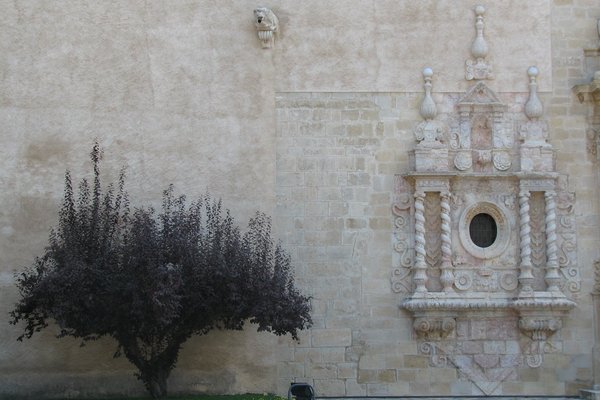Spain
Poblet Monastery
Poblet Monastery is one of the largest and most complete Cistercian abbeys in the world.
The building from the 12th to 14th centuries also is a massive military complex and has served as a royal palace, residence, and the pantheon of the Kings and Queens of Catalonia and Aragon. Some of the most important royal sepulchres have alabaster statues that lie over the tomb and the Abbey has a noteworthy alabaster altarpiece by Damià Forment.
Community Perspective: The monastery has a picturesque location. Clyde recommends hiking the Espluga de Francoli loop trail around the monastery walls (ca. 1h), while Hubert has described the many highlights of the interior. Visitor instructions are a bit "Spanish" - you'll have to join a guided tour or at least adhere to their timings (see Ilya's review of how that works out for a non-Spanish speaker), although in Nov 2023 it seems from the official website that the tour now is carried out via an app.
Site Info
Official Information
- Full Name
- Poblet Monastery (ID: 518)
- Country
- Spain
- Status
-
Inscribed 1991
Site history
History of Poblet Monastery
- 1991: Inscribed
- Inscribed
- 1989: Deferred
- Boundaries to be defined
- Type
- Cultural
- Criteria
- i
- iv
Links
- UNESCO
- whc.unesco.org
- Official
-
- poblet.cat — Poblet Monastery
All Links
UNESCO.org
- whc.unesco.org — whc.unesco.org/
Official Website
- poblet.cat — Poblet Monastery
Community Information
- Community Category
- Religious structure: Christian
Travel Information
Catalonia hotspot
Recent Connections
-
Spanish Royal Residences
The palace of King Martin the Human, lo… -
Romanesque
"the Romanesque chapel of Santa Caterin… -
Renaissance
"the Renaissance alabaster retable of t…
Connections of Poblet Monastery
- History
-
-
Spanish Royal Residences
The palace of King Martin the Human, located within the third enclosure of the Poblet monastery, was built in 1397 by special wish and order of King Martin the Human (1356-1410) for his and his family's residence.See es.wikipedia.org
-
Contains significant structures from the 21st Century
"In 2010, Spanish architect Mariano Bayón designed the Poblet Monastery Guesthouse."See en.wikipedia.org
-
- Architecture
-
-
Grotesques
The altarpiece in alabaster by Damián Forment is a Roman-style altarpiece with a Renaissance architectural design and grotesquesSee es.wikipedia.org
-
Octagons
The Gothic dome of the abbey church is octagonal.See es.wikipedia.org
-
Baroque
n a straight line with the Golden Gate, you can see the access door to the atrium of the monastery church, opened in the wall surrounding the 3rd enclosure. It is a 17th century baroque gate that was built by the Duke of Cardona in 1670.See es.wikipedia.org
-
Domes
The Gothic dome of the abbey church.See es.wikipedia.org
-
Gothic
The outer enclosure "contains the Gothic chapel of Sant Jordi, built in 1452." – "Mature Gothic forms dominate the great cloister." (OUV) - The south nave of the church and the dome are Gothic. The palace of King Martin the Human in the third enclosure is considered one of the jewels of civil Gothic art in Catalonia.See es.wikipedia.org
-
Romanesque
"the Romanesque chapel of Santa Caterina" (OUV) - The north nave of the church is Romanesque with a ribbed vault. The central nave is also Romanesque but has a pointed barrel vault.See es.wikipedia.org
-
Renaissance
"the Renaissance alabaster retable of the high altar" by Damián Forment (OUV)
-
- World Heritage Process
-
-
Extended from original TWHS
"ICOMOS had previously recommended inclusion of this site on the condition that the proposed delimitation of the site be adjusted to include the outer enceinte of the monastery. This condition having been met and a modified restoration policy at the site having been adopted, ICOMOS is now prepared to recommend without reserve that this site be included on the World Heritage List." (AB Ev)
-
- Religion and Belief
- Human Activity
-
-
Inscribed significantly for a Work of Fine Art by a single artist
"The abbey contains masterpieces from every period such as the great alabaster altarpiece by Damià Forment (1529)." (OUV) -
Vineyards
Monastic Vineyard
-
- Constructions
-
-
Dynastic Burial Places
Kings and queens of Catalonia and Aragon -
Cemeteries
"(...) even the space reserved for the dead seems regulated in the same spirit, i.e. a cemetery for monks, one for lay brothers and one for the laity." (AB Ev) -
Hospitals
"the second enclosure, made up of the Plaça Major, or Main Square, around which stand the remains of the hospital for the poor (...)" (OUV) -
Prison
The two towers on either side of the Puerta Real were prison towers.See es.wikipedia.org
-
- Timeline
-
-
Built in the 12th century
Criterion I: Poblet is a unique artistic achievement and one of the most perfect expressions of Cistercian style in the 12th, 13th and 14th centuries. (AB ev)
-
- WHS Hotspots
-
-
Catalonia hotspot
Train to Espluga (2h) and then hike or taxi for the final 3.8 km
-
News
No news.
Recent Visitors
Visitors of Poblet Monastery
- 2Flow2
- Adolfo
- Afshin Iranpour
- Alberto Rodriguez Gutierrez
- Alexander Barabanov
- Alexander Lehmann
- A. Mehmet Haksever
- Ammon Watkins
- Ana Lozano
- Andrew_Kerr
- Anna Wludarska
- Argo
- arnaugir
- Aspasia
- Atila Ege
- BaziFettehenne
- Bin
- Boj
- Brendan Carroll
- campmany
- Can SARICA
- Caspar
- Cezar Grozavu
- Christian Wagner
- Christravelblog
- Claire Bradshaw
- Clyde
- Corinne Vail
- Cristina Erba
- CugelVance
- Daniela Hohmann
- Dan Pettigrew
- David Aaronson
- David Berlanda
- David Marton
- DavidS
- Dimitar Krastev
- Dimitrios Polychronopoulos
- Dirk-pieter
- Dolemite92
- Dorejd
- Dr. Caligari
- Dwight Zehuan Xiao
- Echwel
- Elaine McArdle
- Elf21
- Elia Vettorato
- Els Slots
- Emilia
- Emili Xaus
- Erik Jelinek
- Eva Kisgyorgy
- Evgenii
- Fan Yibo
- Feldhase
- Femke Roos
- Filip Murlak
- Gary Arndt
- GeorgeIng61
- Gernot
- Grzegorz Andruszkiewicz
- Harry Mitsidis
- Hubert
- Hughes1920
- Iain Jackson
- Ilya Burlak
- Ivan Rucek
- Jana and Matt
- Jan Zimmermann
- Jasam
- Javier
- Jawnbeary
- Jean Lecaillon
- Jeanne OGrady
- Jens
- Jezza
- João Aender
- Joel on the Road
- Jonas Hagung
- Jonas Kremer
- Jon Eshuijs
- Karito Vies
- kjluebke
- Klaus Freisinger
- krtek
- Lara Adler
- Lisu Marian
- Loic Pedras
- Luboang
- Luis Filipe Gaspar
- Maciej Gil
- Małgosia Łupicka
- Manuelfunk
- marcel staron
- Martinacurra88
- Martina Rúčková
- Marty
- Matthewsharris
- MaYumin
- MH
- Michael Novins
- Mikko
- Milan Jirasek
- MMM
- Msarmiento1979
- Mstrebl1990
- nan
- napalm
- Niall Sclater
- Nihal Ege
- Nuria8
- PabloNorte
- Palimpsesto
- Patrik
- Paul Schofield
- PeterH
- Petteri
- Philipp Leu
- Philipp Peterer
- Porcho
- Randi Thomsen
- RobRos
- Roger Ourset
- Roman Bruehwiler
- Sabrina Liebehentschel
- scubarrie
- serghei.belous
- Sergio Arjona
- Shandos Cleaver
- sime147
- Simonh
- Solivagant
- Sorel Americo
- Stanislaw Warwas
- Svein Elias
- Szucs Tamas
- Tamara Ratz
- Taotao Chen
- Tarquinio_Superbo
- Tevity
- Thomas Buechler
- Thomas van der Walt
- Tim Allen
- Tonisan
- tony0001
- triath
- Vanessa Buechler
- Van Hung
- Viaje al Patrimonio
- Vincent Cheung
- VLabhard
- voyager
- WILLIAM RICH
- Wojciech Fedoruk
- Xiong Wei
- Xiquinho Silva
- YaroMir
- Zoë Sheng
- Zos M
Community Reviews
Show full reviews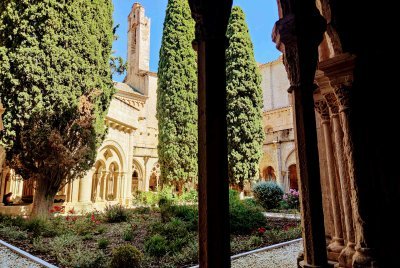
I have to agree with Andrew_Kerr that this site deserves higher ratings than it was previously receiving, and from reading the older reviews it seems to be largely due to the way in which the tour system has been re-worked. Whereas previously an in-person tour was required, the availablity of these has now become significantly more limited as they have been supplanted with an audio guide that you can use to enter the full monastery at any time and tour at your own pace. (I say "full monastery" to refer to the large section open to tourists, though, as this is still an actively used monastery so there are sections exclusively reserved for the monks which travellers cannot enter.)
Poblet is located decently far away from any major cities, so the tourist traffic here is significantly less than you'll find in other WHS sites. I've been a little bit over-exposed to monasteries & cathedrals during my past nine months living in Spain so you should expect that if you haven't been seeing a new cathedral every few weeks, this site will impress you even more. The audio guide is well narrated in multiple languages and helpfully tours you through each section and room of the monastery, ensuring you don't miss anything. The stark Cisterian style of architecture with limited decoration is quite powerful and lends to a sense of austerity in the place, but not so much as to make the location boring. It's neat to see all the …
Keep reading 0 comments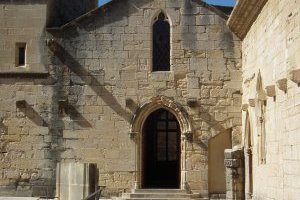
I seem to be bucking the trend here by awarding Poblet 4 stars but I really enjoyed my visit there. It's a very impressive 14th century Cistercian abbey, set among the rolling foothills of the Prades mountains.I usually find an hour is plenty when visiting most cathedrals and abbeys but I happily spent half a day here exploring the various features.Poblet Abbey or to give it its proper name, The Royal Abbey of Santa Maria de Poblet was founded in the 12th century by French Cistercian monks along with 2 other abbeys at Vallbona de les Monges and Santes Creus.Although the building we see today reflects the splendour of the 14th century Gothic abbey, much of it is restored, the building having fallen into disrepair in the 19th century.Of particular interest is the altar, dating from 1527, the cloisters and the tombs of the kings and queens of Aragon. It's also possible to walk on part of the roof (see picture) which I enjoyed immensely.
Keep reading 0 comments
My frequently professed affinity for sacred architecture did not translate into surpassing appreciation of Poblet Monastery. I saw an impressive enough complex which I could not call extraordinary. The historical context of the monastery's importance stayed beyond me. This was largely a function of the constraints of the visit. You can freely wander around the territory inside the outer walls of the monastery, but getting inside the main part of the complex is possible only roughly once an hour in the company of a guide. The tour is conducted in either Spanish or Catalan. If you indicate at the reception that you do not speak either language, you get a small booklet with explanations instead. Then, during the tour, you are allowed to explore on your own and not follow the guided group. Sounds like a pretty good deal for someone who dislikes crowds until you realize that the booklet throws historical facts at you and mentions key features of every space you see without tying it into a coherent picture. I am left wondering whether an ability to understand the tour guide would be key to get more value out of the visit.
That being said, there are certainly some interesting features at Poblet Monastery that can be observed without any guidance. The most obvious of them is the façade of the main church, with a cluster of decorations on an otherwise blank wide wall. The façade opens onto Plaça Major, the wide main square of the complex …
Keep reading 0 comments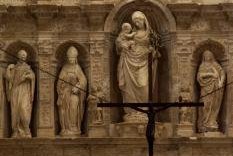
The Poblet Monastery is picturesquely located on a small hill between olive groves, you can see the panorama of its towers from afar. We came from Tarragona by car and when we drove down the street along the outer wall of the monastery we got a first impression of the size of the complex. With its towers, battlements and huge gates it looks more like a medieval fortress than a monastery.
We arrived at a quarter past 11 a.m., a little too late for the regular guided tour, but we met a group from Switzerland and they invited us to join their guided tour. That wasn't bad, because the tour was in English, regular tours are in Spanish, Catalan, or French. First we went through two large gates and crossed two almost empty courtyards, then we had to wait for our guide in front of the Puerta Real, the inner gate flanked by two massive towers. The tour was excellent, the guide gave detailed information and we had plenty of time to visit all rooms, we spent almost two hours in the monastery. Although it is still an active monastery, large parts of the complex are open for visitors. We went through many corridors und stairs and even on the gallery on top of the cloister.
Poblet is a perfect example of Cistercian architecture and its aesthetic principles. No pomp or lavish decoration, but simple and functional architecture, large and high rooms with harmonious proportions. Wonderful examples are the refectory …
Keep reading 0 comments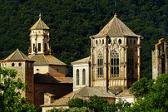
I visited this WHS in May 2014. Since I was arriving late from Andorra I decided to sleep at Hostatgeria de Poblet which is actually inside the Poblet Monastery Walls and it's great value for money especially considering that you get a 3 euro discount to visit the monastery too. Although the monastery opens at 10am, I still woke up early in time to listen to the monks' vespers at 07:30. After that I hiked the Espluga de Francoli loop trail around the monastery walls which took me around an hour during which I passed through olive groves, vineyards and orchards. The views of the monastery from here are wonderful in the early morning light (photo) while the best time to take pictures of the Monastery entrance is in the afternoon. Prices have gone up and it now costs 10euros for a guided tour in Spanish or 7.50euros to visit without a guide, although you will still have to wait for the guide to open the door at 10.30am (very Spanish!) and follow the guide's instructions to how much time you're allowed in each floor before she closes the door. Overall, I had more than enough time to visit the monastery (around 2 hours) and follow the brochure in English however it's a bit of a pain that you can't exit before you reach the end of the tour and that you can't spend more time inside if you so wanted. The highlight of my visit was the walking trail …
Keep reading 0 comments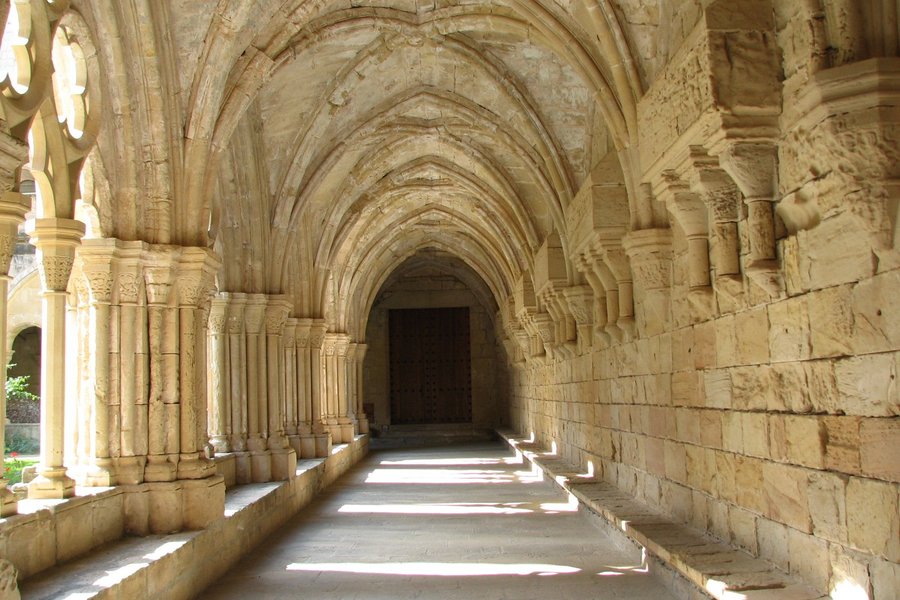
This monastery was well worth a visit. I discovered that certain buses operating between Tarragona and Lleida detour via the entrance to the monastery, and that it was possible to make an afternoon visit from Tarragona that way.
Keep reading 0 comments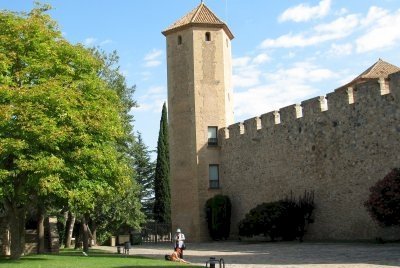
We rented a car to go to Poblet from Barcelona, it took us about 1.5 hours to get there. The monastery's sharp, edgy towers make a pretty sight from a distance. We were there early (at 10 a.m., when it opens to the public), not many other cars in the huge car park next door.
The entrance fee of 5 EUR includes a guided tour. They are only given in Spanish, Catalan, and French - but we were provided with a booklet in Dutch and could tag along with a Spanish group. The friendly guide made sure that we got the main message of each part of the tour.
The tour was a bit too hurried to our taste: we would have liked to stay in the various rooms a bit longer.
Keep reading 0 comments
The Cistercian monastery of Poblet is one of the more interesting and impressive buildings I have been to. The fact that it houses the tombs of a long line of kings and queens of Aragon in a great pantheon makes it especially noteworthy. Anybody coming to Catalonia should try to visit Poblet, located in the hills northwest of Tarragona, since you will hardly ever come across a better monastery anywhere. Having said that, however, you should either have a private car or join a bus tour, since reaching Poblet by public transport is very inconvenient, to say the least. I didn't really mind the 4-km walk from the nearest train station, since the weather was great even in late October, but I don't think many people would do the same (and there were hardly any signs).
Keep reading 0 comments
